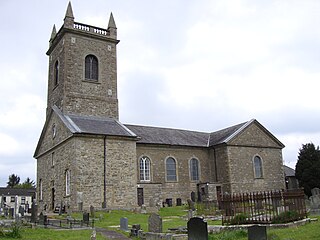
The Bishop of Clogher is an episcopal title which takes its name after the village of Clogher in County Tyrone, Northern Ireland. Following the Reformation, there are now parallel apostolic successions: one of the Church of Ireland and the other of the Roman Catholic Church.
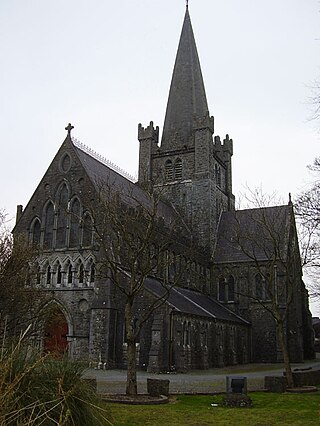
The Archbishop of Tuam is an archbishop which takes its name after the town of Tuam in County Galway, Ireland. The title was used by the Church of Ireland until 1839, and is still in use by the Catholic Church.
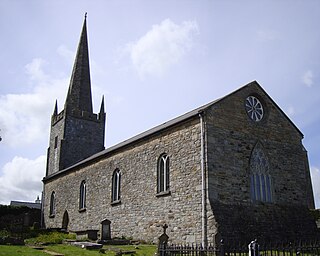
The Bishop of Killala is an episcopal title which takes its name after the village of Killala in County Mayo, Ireland. In the Roman Catholic Church it remains a separate title, but in the Church of Ireland it has been united with other bishoprics.
Patrick Tyrrell, O.F.M. was an Irish prelate of the Roman Catholic Church who served as the Bishop of Clogher (1676–1689), Vicar Apostolic of Kilmore (1678–1689), and Bishop of Meath (1689–1692). A prominent Jacobite, he was appointed Chief Secretary for Ireland in 1688.

The Diocese of Ardagh and Clonmacnoise is a Latin Church diocese of the Catholic Church in Ireland.

The Bishop of Ardagh was a separate episcopal title which took its name after the village of Ardagh, County Longford in Ireland. It was used by the Roman Catholic Church until 1756, and intermittently by the Church of Ireland until 1839.
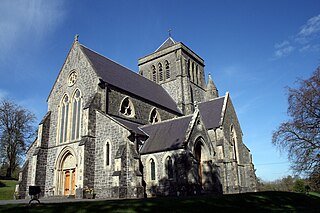
The Bishop of Kilmore is an episcopal title which takes its name after the parish of Kilmore, County Cavan in Ireland. In the Roman Catholic Church it remains a separate title, but in the Church of Ireland it has been united with other bishoprics.
The Bishop of Meath is an episcopal title which takes its name after the ancient Kingdom of Meath. In the Roman Catholic Church it remains as a separate title, but in the Church of Ireland it has been united with another bishopric.

The Bishop of Kildare and Leighlin is the ordinary of the Roman Catholic Diocese of Kildare and Leighlin, one of the suffragan dioceses of the Archdiocese of Dublin. The episcopal title takes its name from the towns of Kildare and Old Leighlin in the province of Leinster, Ireland.
The Bishop of Waterford and Lismore is an episcopal title which takes its name after the city of Waterford and town of Lismore in Ireland. The title was used by the Church of Ireland until 1838, and is still used by the Roman Catholic Church.

The Archbishop of Armagh is an archiepiscopal title which takes its name from the city of Armagh in Northern Ireland. Since the Reformation, there have been parallel apostolic successions to the title: one in the Roman Catholic Church and the other in the Church of Ireland. The archbishop of each denomination also holds the title of Primate of All Ireland.
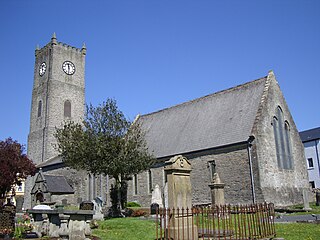
The Bishop of Raphoe is an episcopal title which takes its name after the town of Raphoe in County Donegal, Ireland. In the Roman Catholic Church it remains a separate title, but in the Church of Ireland it has been united with another bishopric.
Bishop of Clonmacnoise was the ordinary of the Roman Catholic episcopal see based at Clonmacnoise, County Offaly, Ireland. The bishops of Clonmacnoise appear in the records for the first time in the 9th century, although inferior in status to the Abbot of Clonmacnoise until the reformation of the Irish Church in the 12th century. After the Reformation, there were several parallel bishops placed by the Church of Ireland until the Diocese of Clonmacnoise was merged with Diocese of Meath to form the Diocese of Meath and Kildare in 1569. In the Roman Catholic Church, separate bishops continued longer. The diocese came under the administration of the Bishop of Ardagh between 1688 and 1725, before the provision of Stephen MacEgan in 1725. Although MacEgan was translated to Meath in 1729, he continued to administer Clonmacnoise separately until his death in 1756, after which the see was finally merged into the Roman Catholic Diocese of Ardagh and Clonmacnoise.

The Bishop of Elphin is an episcopal title which takes its name after the village of Elphin, County Roscommon, Ireland. In the Roman Catholic Church it remains a separate title, but in the Church of Ireland it has been united with other bishoprics.
Austin Quinn (1892–1974) was an Irish prelate of the Roman Catholic Church who served as the Bishop of Kilmore from 1950 to 1972.
Patrick Finegan (1858–1937) was an Irish prelate of the Roman Catholic Church who served as the Bishop of Kilmore from 1910 to 1937.
Andrew Boylan, C.Ss.R. (1842–1910) was an Irish prelate of the Roman Catholic Church who served as the Bishop of Kilmore from 1907 to 1910.
Bernard Finegan was an Irish prelate who briefly served in the Roman Catholic Church as the Bishop of Kilmore from 1886 to 1887.
Richard Brady, O.F.M. was an Irish prelate of the Roman Catholic Church who served as Bishop of Ardagh from 1576 to 1580 and then Bishop of Kilmore from 1580 to 1607.
Augustine Cheevers was an Irish Roman Catholic clergyman A member of the Order of Saint Augustine (OSA).










